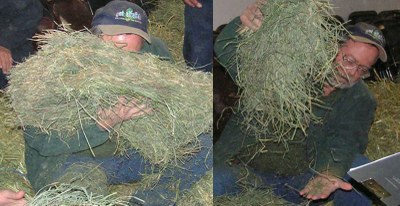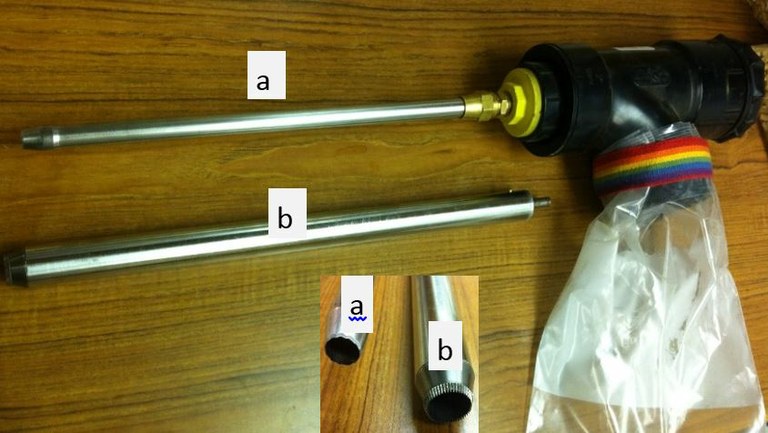Managing Hay Resources: When the Sun Won’t Shine!
While we have been blessed with plenty of moisture in most parts of North Dakota this spring and early summer it has made “making hay while the sun shines” fairly challenging.
Putting up the desired quality of hay involves cutting at the proper stage of maturity and being able to get it dry enough to bale and stack. Delays in cutting may slightly increase yields but significantly reduce quality as plants become more mature, however letting hay lay in a windrow and get wet also reduces the quality and yield of the finished product. The primary weather related losses are caused by:
- Leaching of soluble carbohydrates, proteins, minerals, and vitamins.
- Repeated re-wetting can increase and prolong plant respiration further increasing nutrient and yield reductions.
- Mechanical handling (raking and tedding) to improve dry down increases leaf shattering and subsequent quality and yield losses.
- Wet hay increases mold growth and microbial activity which further reduce quality and increase plant nutrient breakdown.
- Reduced aesthetic appearance due to bleaching, not a good indication of quality losses.
Rain during hay dry down is not as detrimental on quality as rain events that occur as the hay gets closer to being ready to package. Soaking rains that fall more gently, tend to leach a greater amount of nutrients. Generally crude protein levels are only slightly affected when field cured hay gets rained on prior to baling. However digestibility can be reduced significantly from 72% when cured without rain, down to 49% after 2.4 inches of rain on nearly dry hay (Collins, 1983). Conversely, both neutral detergent fiber and acid detergent fiber can increase over 20%, as they are comprised of mostly structural carbohydrates (Collins, 1983). Once cut and in a package we can’t change the losses that occurred but we can quantify them and manage the hay to best match the nutrient needs of the livestock intended to consume it. A proper evaluation of hay quality involves both a visual and a laboratory analysis.
Visual Evaluation
 The visual evaluation, often referred to as a sensory evaluation, involves using both sight and smell. Visually inspect for stage of maturity, forage species, and any foreign matter (Figure 1). Odor can indicate heat damage (sweet tobacco or caramel like smell) and presence of mold. Color is not a good measurement of quality, a sun bleached hay can still be higher quality than another hay that is bright green. Laboratory Analysis of forage quality is the best and only accurate indication of how a hay will meet livestock nutrient needs.
The visual evaluation, often referred to as a sensory evaluation, involves using both sight and smell. Visually inspect for stage of maturity, forage species, and any foreign matter (Figure 1). Odor can indicate heat damage (sweet tobacco or caramel like smell) and presence of mold. Color is not a good measurement of quality, a sun bleached hay can still be higher quality than another hay that is bright green. Laboratory Analysis of forage quality is the best and only accurate indication of how a hay will meet livestock nutrient needs.
Figure 1. Sensory evaluation of hay smelling and visually inspecting hay for dust and foreign material.
Laboratory Evaluation
Proper sampling technique is important in getting an accurate laboratory analysis result. Grab samples are highly inaccurate and frankly a waste of your time, effort and money. To get the best analysis, a hay probe with a sharp tip (Figure 2) should be utilized to properly core and sample at least 20 bales within the same lot of hay. Both Near Infrared (NIRS) and wet chemistry are great analysis procedures, as long as a reputable forage lab is utilized. To select a lab see the National Forage Testing Association (NFTA) link below. Once you get the results back, purchase and organize your hay resources based on the nutrient requirement needs for the type of livestock, age, and stage of production (see link below for more information on understanding and interpreting forage analysis results).

Figure 2. Example of two hay probe types. (a) Push type multi-core sampler with beveled, re-sharpenable tip (star quality samplerTM);
(b) Single core drill attachment, PensylvaniaTM type sampler with serrated tip.
Links for Additional Information and Resources:
National Forage Testing Association; Sampling Feeds for Analysis; Hay probe links; Selecting a laboratory; Interpreting Forage Analysis; Preventing Hay fires
Chanda Engel
Livestock Research Specialist


